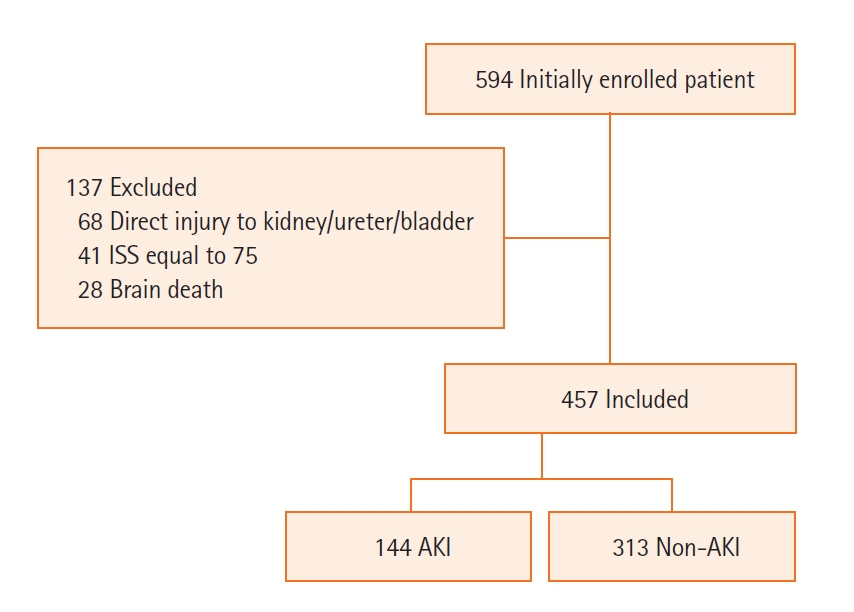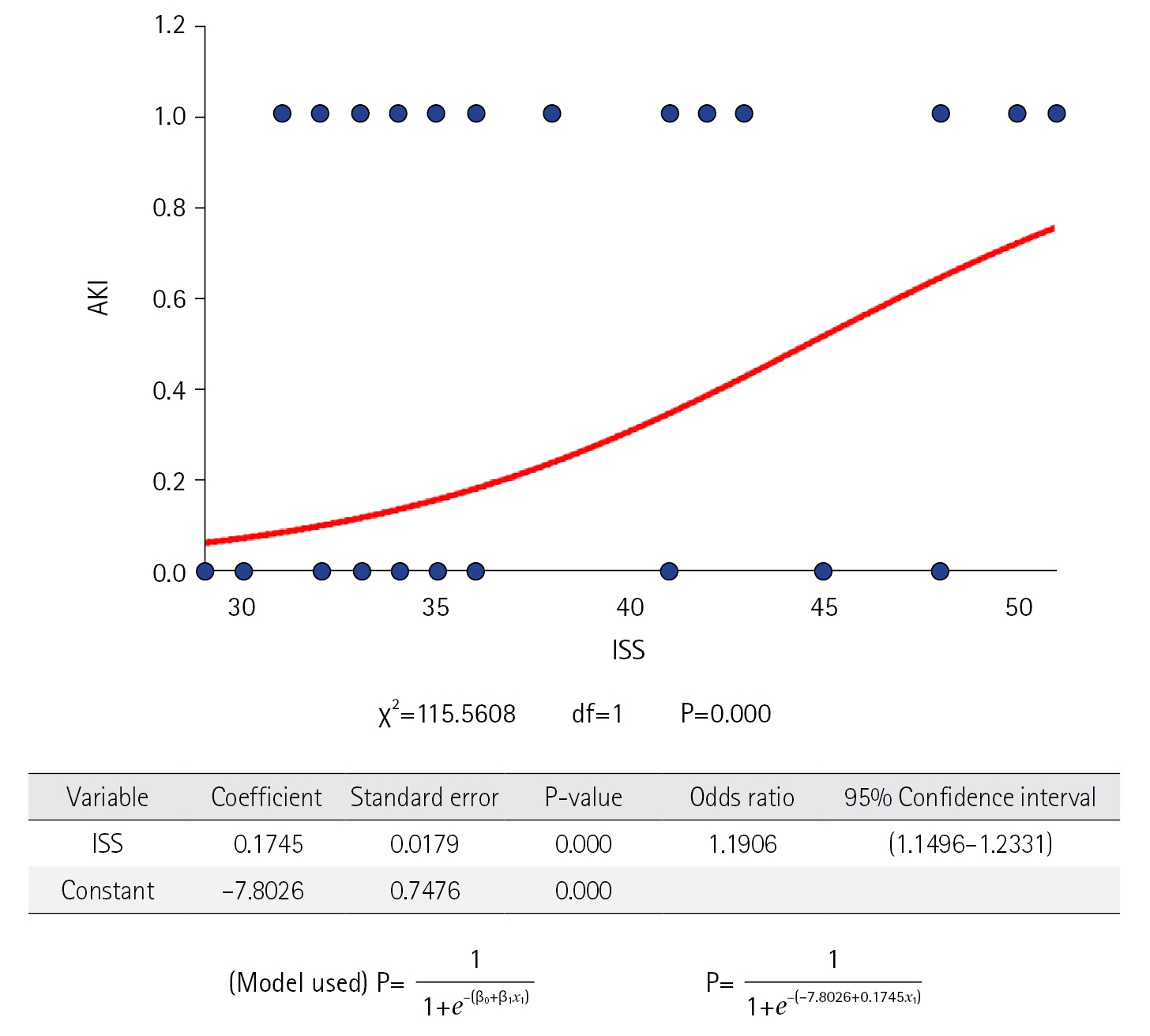Acute Crit Care.
2023 May;38(2):217-225. 10.4266/acc.2023.00388.
Epidemiology and outcome of an acute kidney injuries in the polytrauma victims admitted at the apex trauma center in Dubai
- Affiliations
-
- 1Department of Surgical Intensive Care Medicine, Rashid Hospital, Oud Metha, Dubai, UAE
- 2College of Medicine, Mohammed Bin Rashid University of Medicine and Health Sciences, Dubai, UAE
- 3Dubai Medical College, Dubai, UAE
- 4Emergency Department, Emirates Hospital, Jumeirah, Dubai, UAE
- KMID: 2543641
- DOI: http://doi.org/10.4266/acc.2023.00388
Abstract
- Background
Polytrauma from road accidents is a common cause of hospital admissions and deaths, frequently leading to acute kidney injury (AKI) and impacting patient outcomes. Methods: This retrospective, single-center study included polytrauma victims with an Injury Severity Score (ISS) >25 at a tertiary healthcare center in Dubai. Results: The incidence of AKI in polytrauma victims is 30.5%, associated with higher Carlson comorbidity index (P=0.021) and ISS (P=0.001). Logistic regression shows a significant relationship between ISS and AKI (odds ratio [OR], 1.191; 95% confidence interval [CI], 1.150–1.233; P<0.05). The main causes of trauma-induced AKI are hemorrhagic shock (P=0.001), need for massive transfusion (P<0.001), rhabdomyolysis (P=0.001), and abdominal compartment syndrome (ACS; P<0.001). On multivariate logistic regression AKI can be predicated by higher ISS (OR, 1.08; 95% CI, 1.00–1.17; P=0.05) and low mixed venous oxygen saturation (OR, 1.13; 95% CI, 1.05–1.22; P<0.001). The development of AKI after polytrauma increases length of stay (LOS)-hospital (P=0.006), LOS-intensive care unit (ICU; P=0.003), need for mechanical ventilation (MV) (P<0.001), ventilator days (P=0.001), and mortality (P<0.001). Conclusions: After polytrauma, the occurrence of AKI leads to prolonged hospital and ICU stays, increased need for mechanical ventilation, more ventilator days, and a higher mortality rate. AKI could significantly impact their prognosis.
Keyword
Figure
Reference
-
1. Elessawy F. The boom: population and urban growth of Dubai city. Horizons Hum Soc Sci. 2017; 2:26–41.
Article2. Bener A, Crundall D. Road traffic accidents in the United Arab Emirates compared to Western countries. Adv Transp Stud Int J. 2005; 6:5–12.3. Barss P, Addley K, Grivna M, Stanculescu C, Abu-Zidan F. Occupational injury in the United Arab Emirates: epidemiology and prevention. Occup Med (Lond). 2009; 59:493–8.
Article4. Perkins ZB, Captur G, Bird R, Gleeson L, Singer B, O'Brien B. Trauma induced acute kidney injury. PLoS One. 2019; 14:e0211001.
Article5. Don Bosco D, Gangalal GM, Rao S, Chakrapani AT. Acute kidney injury in severe trauma patients: a record-based retrospective study. Adv J Emerg Med. 2019; 3:e22.6. Muhamedhussein MS, Manji M, Nungu KS, Ruggajo P, Khalid K. Prevalence and risk factors of acute kidney injury in polytrauma patients at Muhimbili Orthopedic Institute, Tanzania. Afr J Emerg Med. 2021; 11:74–8.
Article7. Ahmed N, Mathew RO, Kuo YH, Md AA. Risk of severe acute kidney injury in multiple trauma patients: risk estimation based on a national trauma dataset. Injury. 2020; 51:45–50.
Article8. Søvik S, Isachsen MS, Nordhuus KM, Tveiten CK, Eken T, Sunde K, et al. Acute kidney injury in trauma patients admitted to the ICU: a systematic review and meta-analysis. Intensive Care Med. 2019; 45:407–19.
Article9. Quan H, Li B, Couris CM, Fushimi K, Graham P, Hider P, et al. Updating and validating the Charlson comorbidity index and score for risk adjustment in hospital discharge abstracts using data from 6 countries. Am J Epidemiol. 2011; 173:676–82.
Article10. Copes WS, Champion HR, Sacco WJ, Lawnick MM, Keast SL, Bain LW. The Injury Severity Score revisited. J Trauma. 1988; 28:69–77.
Article11. Patil V, Shetmahajan M. Massive transfusion and massive transfusion protocol. Indian J Anaesth. 2014; 58:590–5.
Article12. Cabral BM, Edding SN, Portocarrero JP, Lerma EV. Rhabdomyolysis. Dis Mon. 2020; 66:101015.
Article13. Martin D, Mantziari S, Demartines N, Hübner M, ESA Study Group. Defining major surgery: a Delphi consensus among European Surgical Association (ESA) members. World J Surg. 2020; 44:2211–9.
Article14. Kellum JA, Lameire N; KDIGO AKI Guideline Work Group. Diagnosis, evaluation, and management of acute kidney injury: a KDIGO summary (Part 1). Crit Care. 2013; 17:204.
Article15. Sosa G, Gandham N, Landeras V, Calimag AP, Lerma E. Abdominal compartment syndrome. Dis Mon. 2019; 65:5–19.
Article16. Chawla LS, Bellomo R, Bihorac A, Goldstein SL, Siew ED, Bagshaw SM, et al. Acute kidney disease and renal recovery: consensus report of the Acute Disease Quality Initiative (ADQI) 16 Workgroup. Nat Rev Nephrol. 2017; 13:241–57.
Article17. Tandukar S, Palevsky PM. Continuous renal replacement therapy: who, when, why, and how. Chest. 2019; 155:626–38.18. Ortega-Loubon C, Martínez-Paz P, García-Morán E, Tamayo-Velasco Á, López-Hernández FJ, Jorge-Monjas P, et al. Genetic susceptibility to acute kidney injury. J Clin Med. 2021; 10:3039.
Article19. Vilander LM, Kaunisto MA, Pettilä V. Genetic predisposition to acute kidney injury: a systematic review. BMC Nephrol. 2015; 16:197.20. Li Y, Ren K. The mechanism of contrast-induced acute kidney injury and its association with diabetes mellitus. Contrast Media Mol Imaging. 2020; 2020:3295176.
Article21. Prowle JR, Forni LG, Bell M, Chew MS, Edwards M, Grams ME, et al. Postoperative acute kidney injury in adult non-cardiac surgery: joint consensus report of the Acute Disease Quality Initiative and PeriOperative Quality Initiative. Nat Rev Nephrol. 2021; 17:605–18.
Article22. Zhang L, Lin M, Tang X, Tang Y. Correlation between coagulation fibrinolysis function and outcomes during hospitalization in patients with severe traumatic hemorrhagic shock. Emerg Med Int. 2022; 2022:3775868.
Article23. Elgin LB, Appel SJ, Grisham D, Dunlap S. Comparisons of trauma outcomes and injury severity score. J Trauma Nurs. 2019; 26:199–207.
Article24. Assanangkornchai N, Akaraborworn O, Kongkamol C, Kaewsaengrueang K. Characteristics of creatine kinase elevation in trauma patients and predictors of acute kidney injury. J Acute Med. 2017; 7:54–60.25. Holodinsky JK, Roberts DJ, Ball CG, Blaser AR, Starkopf J, Zygun DA, et al. Risk factors for intra-abdominal hypertension and abdominal compartment syndrome among adult intensive care unit patients: a systematic review and meta-analysis. Crit Care. 2013; 17:R249.
Article26. Tiwari AR, Pandya JS. Study of the occurrence of intra-abdominal hypertension and abdominal compartment syndrome in patients of blunt abdominal trauma and its correlation with the clinical outcome in the above patients. World J Emerg Surg. 2016; 11:9.
Article27. Skinner DL, Kong VY, de Vasconcellos K, Bruce JL, Bekker W, Laing GL, et al. Acute kidney injury on presentation to a major trauma service is associated with poor outcomes. J Surg Res. 2018; 232:376–82.
Article28. Linn S, Linn R, Sheps S, Sarid M, Michaelson M, Geva H, et al. Injury severity scoring and length of stay in hospital of war casualties: demonstration of an association and possible selection bias. Int J Epidemiol. 1993; 22:905–10.
Article29. Tamim H, Al Hazzouri AZ, Mahfoud Z, Atoui M, El-Chemaly S. The injury severity score or the new injury severity score for predicting mortality, intensive care unit admission and length of hospital stay: experience from a university hospital in a developing country. Injury. 2008; 39:115–20.
Article
- Full Text Links
- Actions
-
Cited
- CITED
-
- Close
- Share
- Similar articles
-
- Plastic surgery in a trauma center: a multidisciplinary approach for polytrauma patients
- Successful nonoperative management of a simultaneous high-grade splenic injury and devascularized kidney in Australia: a case report
- Associated Injuries in Spine Trauma Patients: A Single-Center Experience
- Percutaneous screw fixation and external stabilization as definitive surgical intervention for a pelvic ring injury combined with an acetabular fracture in the acute phase of polytrauma in Korea: a case report
- The Effect of Polytrauma on the Follow-Up Neuroimaging and Patients' Prognosis



